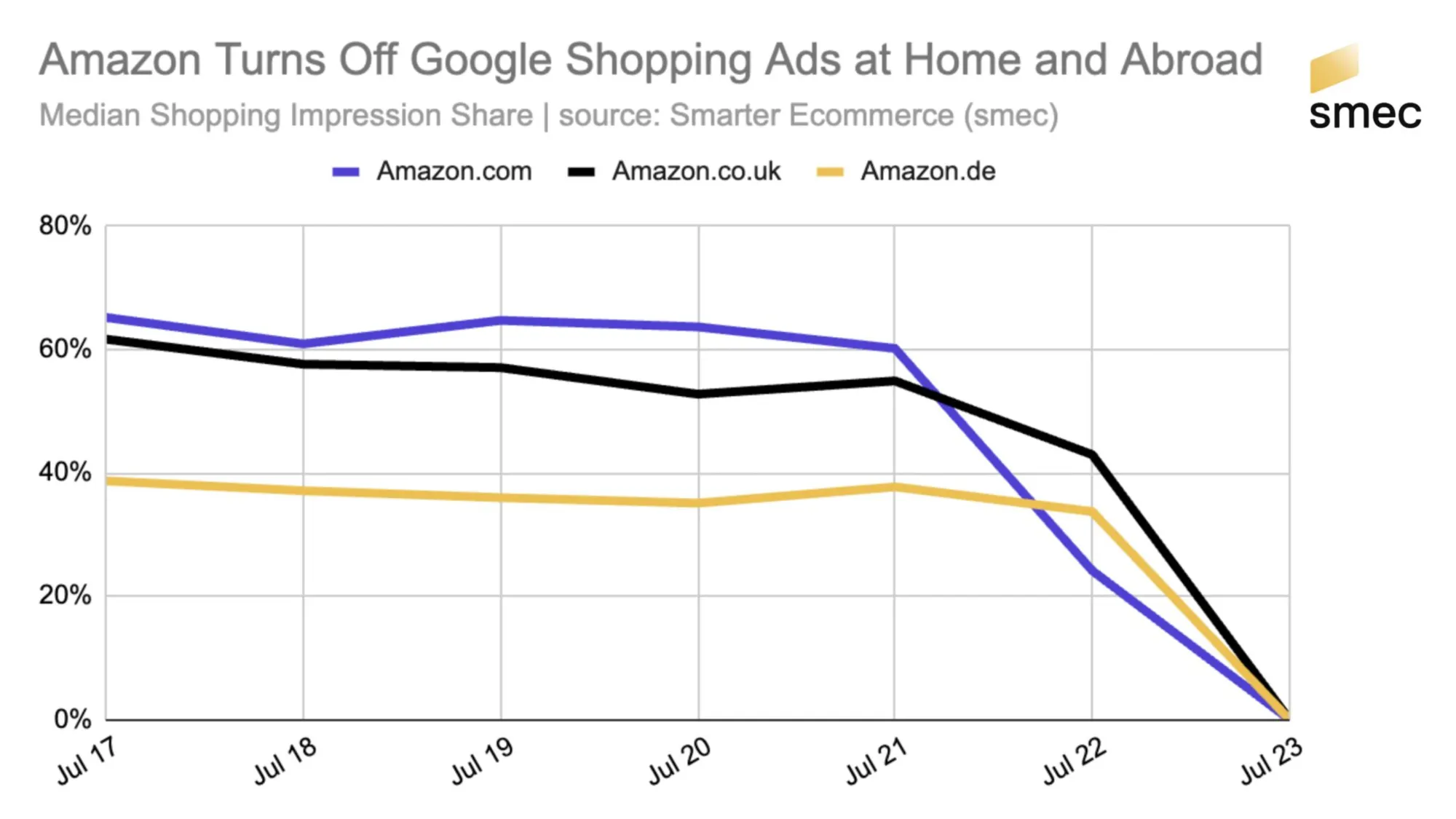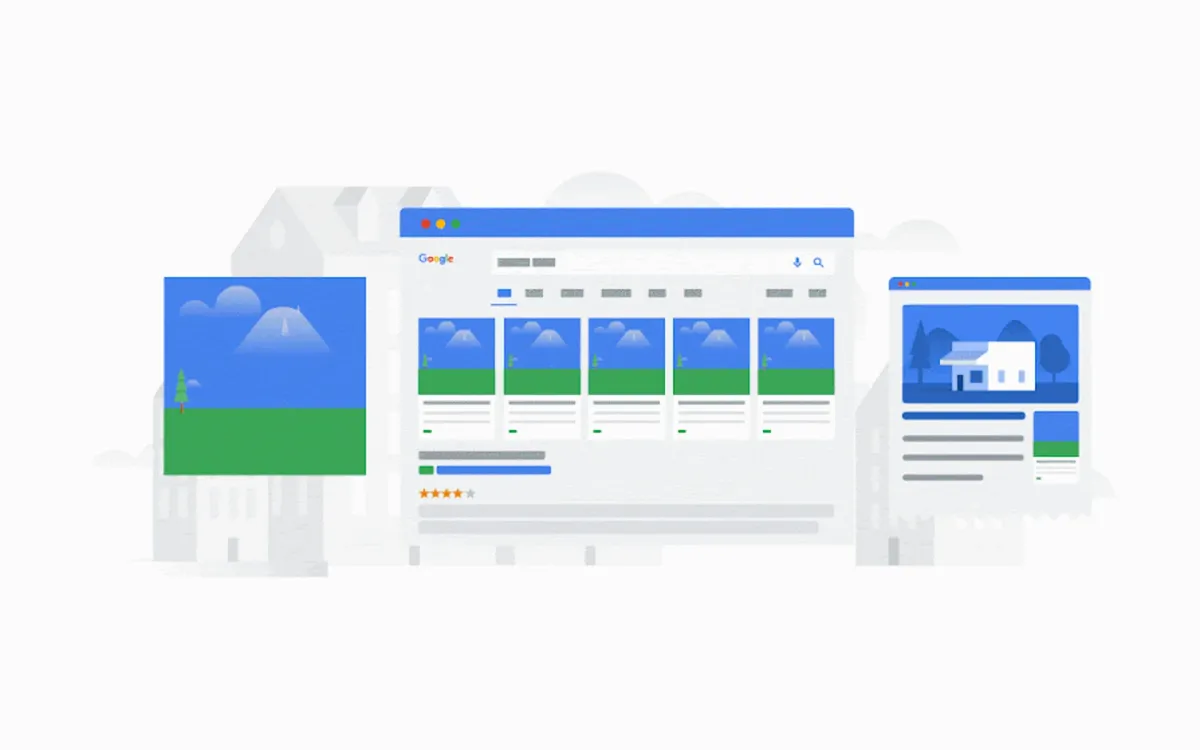Amazon removes all Google Shopping ads globally in 48 hours
Amazon withdraws completely from Google Shopping between July 21-23, ending its global advertising presence across US, UK, and German markets.

Amazon removed its entire Google Shopping advertising presence across multiple global markets between July 21 and July 23, 2025, according to industry analysts tracking the unprecedented move. The e-commerce giant's median Shopping ad impression share crashed to zero percent across major territories: from approximately 60% to 0% in the United States, 55% to 0% in the United Kingdom, and 38% to 0% in Germany.
Mikael Brakker, L'Oréal Luxe E-Commerce Director for Europe Zone, first documented the dramatic withdrawal through LinkedIn analytics on July 25. "Amazon erased itself from Google Shopping in 48 hours - cause the richest click is the one you don't buy," Brakker wrote, noting the complete elimination occurred between July 21 and July 23, 2025.
Mike Ryan, Head of Ecommerce Insights at Smarter Ecommerce, confirmed the withdrawal through multiple data sources. "Rumor has it that Amazon has turned off Google Shopping ads. I will be able to confirm & analyze this in detail via Auction Insights in a couple of days," Ryan posted on social media platform X on July 24, before confirming the complete removal the following day.
The withdrawal represents Amazon's most significant advertising strategy shift since a similar blackout during 2020 lockdowns. According to market observers, Amazon had already reduced its Google Shopping spend by 50% in the United States during May 2025, suggesting the July withdrawal followed months of strategic planning rather than an impulsive decision.
David Kyle, a digital marketing analyst, reported additional complications beyond paid advertising removal. "Have they completely disconnected Merchant Center altogether? I can't get them to show up for anything in Free Listings. This is drilling down on Amazon products like Fire and Kindle. I click more stores until all it does is show me ebay listings," Kyle noted on social media.
Amazon's removal creates immediate opportunities for competitors in Google's advertising auction system. Lower cost-per-click and higher click-through rates are anticipated benefits for remaining advertisers, though impression share gains will likely flow primarily to other large retailers rather than smaller businesses.
The timing coincides with several significant developments in digital advertising. Google recently updated its auction mechanics, eliminating Performance Max campaign priority over Standard Shopping campaigns in October 2024. These changes altered how different campaign types compete for the same search queries during peak shopping seasons.

Market analysts propose five theories for Amazon's strategic withdrawal:
- First, the move serves as an incrementality stress test, similar to Amazon's 2020 experiment to determine which traffic requires paid search investment.
- Second, it represents a post-Prime Day detox strategy, eliminating external advertising spend while maintaining pristine return on advertising spend metrics during back-to-school demand periods.
- Third, the withdrawal constitutes a margin optimization play. By eliminating payments to Google, Amazon keeps customer acquisition costs internal while directing shoppers to its own platform.
- Fourth, the move demonstrates negotiation leverage, potentially pressuring Google to reduce advertising fees through the withdrawal of substantial advertising spend estimated at hundreds of millions of euros.
- Fifth, the removal reflects Amazon's broader strategy in search competition. With Rufus AI assistant and generative search answers expanding globally, Amazon seeks full-funnel customer control before Google's Performance Max campaigns further penetrate e-commerce territory.
The withdrawal affects global markets uniformly. Dario Zannoni from Ayudante confirmed Amazon stopped Shopping ads in Japan, while other analysts verified similar patterns across European markets. "Hi Mike, from what I can see, I can confirm that Amazon stopped its shopping ads even in Japan," Zannoni reported through professional networks.
Amazon's decision reverses years of increasing investment in Google's advertising ecosystem. The company previously expanded its advertising presence through Google Lens Shopping ads integration, which reached nearly 20 billion monthly visual searches with 20% being shopping-related by October 2024.
The withdrawal creates uncertainty for advertising auction dynamics during the crucial holiday shopping preparation period. According to PPC Land's holiday advertising research, 71% of consumers plan to start holiday shopping before Thanksgiving in 2025, representing an 18% year-over-year increase requiring earlier campaign optimization.
Industry experts note Amazon's move comes as artificial intelligence reshapes search experiences. Perplexity launched its AI-powered shopping assistant in November 2024, while Google enhanced its Shopping tab with AI capabilities, creating new competitive pressures in product discovery.
Cost-per-click reductions following Amazon's withdrawal remain limited according to early market observations. Mike Ryan noted through multiple industry sources that significant cost decreases haven't materialized yet, though longer-term effects require additional monitoring as auction dynamics stabilize.
The strategic implications extend beyond immediate advertising costs. Amazon's withdrawal signals its confidence in alternative traffic sources, including direct search behavior and its expanding AI-powered recommendation systems. The company appears willing to sacrifice Google-driven traffic in favor of maintaining higher profit margins and customer relationship control.
Google's response to Amazon's withdrawal will likely influence future retailer relationships. The search giant recently eliminated automatic Performance Max priority over Standard Shopping campaigns, suggesting adaptability to major advertiser concerns about campaign competition dynamics.
Amazon's complete removal from Google Shopping represents the most significant retail advertising strategy shift in recent memory. Whether the withdrawal proves temporary or permanent will determine long-term implications for both Google's advertising revenue and Amazon's customer acquisition strategies.
The move demonstrates how major retailers increasingly view advertising platforms as strategic assets rather than necessary expenses. Amazon's decision prioritizes platform independence over traffic diversification, betting that customer loyalty and direct search behavior provide sufficient growth without external advertising investments.
Future developments depend on several factors including Google's fee structure responses, Amazon's traffic performance without paid search, and competitive retailer reactions to reduced auction competition. The advertising industry watches closely as two technology giants reshape their relationship with implications extending throughout digital commerce.
Timeline
- May 2025: Amazon reduces Google Shopping ad spend by 50% in the United States, signaling strategic shift
- July 21-23, 2025: Amazon completely removes all Google Shopping ads globally across US, UK, Germany, Japan, and other markets
- July 24, 2025: Mike Ryan reports initial observations of Amazon's potential withdrawal from Google Shopping
- July 25, 2025: Mikael Brakker documents complete Amazon withdrawal with impression share data
- July 25, 2025: Mike Ryan confirms Amazon withdrawal across all monitored markets
- October 2024: Google eliminated Performance Max priority over Standard Shopping campaigns, changing auction dynamics
- October 2024: Google Lens introduced Shopping ads with 20 billion monthly visual searches
- November 2024: Perplexity launched AI-powered shopping assistant competing with traditional search
- 2020: Amazon previously conducted similar Google Shopping withdrawal during pandemic lockdowns
Subscribe the PPC Land newsletter ✉️ for similar stories like this one. Receive the news every day in your inbox. Free of ads. 10 USD per year.
Summary
Who: Amazon, the global e-commerce giant, completely withdrew from Google Shopping advertising, affecting Google's advertising revenue and competitor strategies.
What: Amazon eliminated its entire Google Shopping ad presence globally, reducing impression share from 38-60% to 0% across major markets including the US, UK, Germany, and Japan between July 21-23, 2025.
When: The withdrawal occurred over 48 hours between July 21 and July 23, 2025, following a 50% reduction in US advertising spend during May 2025.
Where: The removal affected all global markets where Amazon advertised on Google Shopping, including the United States, United Kingdom, Germany, and Japan, with industry analysts confirming uniform implementation worldwide.
Why: Amazon's strategic withdrawal likely serves multiple purposes: conducting incrementality testing to determine paid search necessity, optimizing profit margins by eliminating external advertising costs, demonstrating negotiation leverage with Google, and asserting greater control over customer acquisition channels as AI-powered search alternatives emerge.
Subscribe the PPC Land newsletter ✉️ for similar stories like this one. Receive the news every day in your inbox. Free of ads. 10 USD per year.
Key Terms Explained
Google Shopping
Google Shopping represents Google's product advertising platform where retailers display product listings with images, prices, and store information directly in search results. The platform operates through Merchant Center integration, allowing businesses to upload product feeds that automatically generate Shopping ads. These advertisements appear prominently in search results and across Google's network, driving traffic to retailer websites. Amazon's withdrawal from this platform eliminates one of the largest e-commerce players from Google's product advertising ecosystem.
Impression Share
Impression share measures the percentage of times an advertiser's ads appear compared to the total number of times they were eligible to show. Amazon's impression share dropped from 38-60% to 0% across major markets, indicating complete advertising withdrawal. This metric helps advertisers understand their market presence and competitive positioning within Google's auction system. The dramatic reduction in Amazon's impression share creates opportunities for other retailers to capture additional visibility.
Performance Max
Performance Max campaigns represent Google's automated advertising solution that uses machine learning to optimize across all Google properties including Search, Display, YouTube, and Shopping. These campaigns automatically adjust bids, audiences, and creative assets to maximize conversions based on advertiser goals. Recent changes eliminated Performance Max priority over Standard Shopping campaigns, altering how different campaign types compete in auctions. This campaign type becomes increasingly relevant as advertisers adapt to Amazon's absence from Google Shopping.
Cost-per-Click (CPC)
Cost-per-click represents the amount advertisers pay each time someone clicks their advertisement. Market analysts anticipated CPC reductions following Amazon's withdrawal due to decreased competition in Google's auction system. However, early observations suggest limited immediate cost decreases, indicating other large retailers quickly absorbed available impression inventory. CPC dynamics remain crucial for understanding advertising efficiency and budget allocation strategies.
Merchant Center
Google Merchant Center serves as the platform where retailers upload and manage product information for Shopping ads and free listings. Amazon's complete withdrawal suggests disconnection from Merchant Center, affecting both paid advertisements and free product listings. This platform integration determines product visibility across Google's shopping experiences, making Merchant Center access essential for e-commerce success. Other retailers may need enhanced Merchant Center optimization to capture Amazon's vacated market share.
Auction Insights
Auction Insights provides advertisers with competitive intelligence about other companies bidding on similar keywords and product categories. Industry analysts like Mike Ryan use Auction Insights data to track competitor presence and market changes. This tool revealed Amazon's complete withdrawal from Google Shopping auctions, confirming the strategic shift. Auction Insights becomes particularly valuable for understanding market dynamics following major competitor exits.
Incrementality Testing
Incrementality testing measures the true impact of advertising spend by comparing performance with and without specific campaigns or channels. Amazon's withdrawal may represent a large-scale incrementality test to determine Google Shopping's actual contribution to sales versus organic traffic. This testing approach helps companies understand which advertising investments drive genuine additional revenue rather than capturing existing demand. The 2020 Amazon blackout provided similar incrementality insights during pandemic conditions.
AI-Powered Search
Artificial intelligence increasingly influences search experiences through tools like Google's AI Overviews, Amazon's Rufus assistant, and emerging platforms like Perplexity's shopping features. Amazon's withdrawal coincides with expanding AI search capabilities that potentially reduce dependence on traditional paid advertising. These technologies change how consumers discover products and make purchasing decisions. AI-powered search represents a fundamental shift in customer acquisition strategies.
Return on Advertising Spend (ROAS)
Return on Advertising Spend measures advertising effectiveness by calculating revenue generated per dollar spent on advertising. Amazon's withdrawal suggests confidence in maintaining ROAS through alternative channels while eliminating Google Shopping costs. High ROAS requirements may have influenced Amazon's decision to eliminate external advertising spend in favor of internal customer acquisition. This metric remains crucial for evaluating advertising efficiency across different platforms.
Click-Through Rate (CTR)
Click-through rate measures the percentage of people who click an advertisement after seeing it, indicating ad relevance and appeal. Analysts anticipate higher CTRs for remaining advertisers as Amazon's absence reduces competition for consumer attention. Improved CTRs can enhance ad quality scores and reduce costs within Google's auction system. This metric helps advertisers understand engagement levels and optimize creative assets for better performance.


